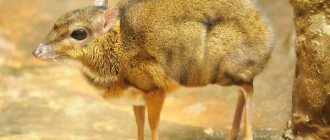Name: Common, South Russian and small-eyed mole rat Lat.:
Spalax microphthalmusClass: Mammals - Mammalia Order: Rodents - Rodentia Family: Mole rats - Spalacidae
| Habitats: | garden |
| Dangerous for: | roots, bulbs and rhizomes |
| Description: | A year-round active animal with a big appetite. |
Description and features
The mole rat belongs to the category of rodents. In the process of evolution, he completely adapted to life underground, which affected his appearance:
- it has a small body, up to 32 cm long;
- the weight of the animal can reach 1 kg;
- ears are missing;
- the paws and tail are short, therefore practically invisible;
- the body is covered with soft dark fur;
- the eyes atrophied and lost the ability to see. Due to the folds of the skin, they became completely invisible.
The mole rat in the photo looks like a mysterious and shy creature.
Spreading
Like the sand mole rat, it lives in the clayey and sandy semi-deserts of the Caspian regions of the north-eastern Ciscaucasia, in the lower reaches of the Sulaka, Terek and Kuma rivers. From r. Kuma to the south extends beyond the Gudermes-Makhachkala line. On the territory of Dogistan it lives in the Terek-Sulak and Terek-Kuma lowlands. This species is distributed unevenly, in patches, in the form of separate settlements.
Mole mole rat
What is the difference between a mole rat and a mole?
Some people mistakenly confuse these rodents with moles, but they are completely different animals. There are two main differences between them:
- The mole rat is much larger.
- The mole builds its tunnels with the help of its paws, but the second one has them poorly developed and has small claws, so it carries out construction work thanks to its front incisors.
- Moles feed on insects, and mole rats prefer roots and plant stems.
Occupation and appearance of mole rats
It turns out that mole rats cause more damage to vegetable gardens than moles. Moles are insectivorous diggers who can annoy summer residents only by digging hills and holes in their plots. Mole rats are real rodents whose delicacies are root vegetables - potatoes, beets, carrots. In addition to vegetables, animals love to eat the stems and leaves of plants and love to eat bulbous flowers.
In addition, shortly before the onset of winter, mole rats stock up on food. The reserves of one rodent alone can reach 10 kilograms. The animals are active all year round and do not hibernate; however, with the onset of cold weather their behavior becomes somewhat calmer.
Features and appearance of the mole rat.
The animal is distinguished by a flat, spade-shaped head, on which there are reduced eyes, in place of which there is a skin fold. The animal has weakly defined ears and a tail, and its body is covered with thick and dense hair.
Many summer residents confuse mole rats with moles, calling them mole moles. But there are many differences between these two animals leading an underground lifestyle.
Kinds
In nature, there are several species of rodents that differ in color, size and place of residence:
- The common or South Russian mole rat has a gray-brown color. It belongs to the most common species. Lives on the territory of Moldova, Ukraine, Russia. Its soft skin is beginning to be used for making fur coats, but not in large quantities, which is why the common mole rat is not yet listed in the Red Book as an endangered species. It is also characterized by a stable population, thanks to which the number of these animals is maintained.
- The giant mole rat is the largest representative, weighing up to a kilogram. It has a light gray or brown coat color. Older individuals have white spots on the head and body. This species is characterized by poor reproduction, which is why it is included in the Red Book of Russia and the International List of Nature Conservation.
- The sandy representative is similar in appearance to its giant relative. Prefers to live in the forest-steppe and near the Dnieper. The rodent is also under protection.
- The Podolsk species is relatively small in size. It is on the verge of extinction and is therefore considered an endangered species.
- The white-toothed is the smallest rodent, whose length barely reaches 20 cm. Its characteristic dark brown color. The mole rat lives in Turkey, Ukraine, Moldova, Romania, Bulgaria, and Greece.
- The Bukovinian representative is slightly different from other species in the shape of its head. This species is found in European countries.
Giant mole rat - Spalax giganteus
Today, the most famous rodent-digger is the mole. And such a representative of the fauna as the giant mole rat remains little known, although it is not inferior in size to the mole. Its brothers (lesser mole rat, common mole rat and sand mole rat) are more common and there is more information about them. The sand mole rat is most similar to the giant mole rat in terms of appearance and biology. This animal is also a very interesting species and has its own characteristics that distinguish it from other representatives of rodent-dwellers.
Sand mole rat
Lesser mole rat
Common mole rat
Lifestyle and habitat
The family of rodents, depending on their habitat, is divided into 4 species, which prefer to live in the desert, forest-steppe, steppe and on the outskirts of forests. They are widespread in Europe, Asia, and Africa. Animals spend almost their entire lives underground. There they set up entire labyrinths, where they feel very comfortable.
An interesting fact is that fleas that parasitize rodents have also evolved and lost their vision. Soils of moderate density are suitable for mole rats. They avoid clay and sandy soil. Rodents choose pastures that have lush vegetation. are often found in the garden .
Features of housing construction
Animals dig out their burrows with their teeth. Even the head is involved in the construction of the labyrinth. The animal bites into the soil with its front teeth and pushes out excess soil from its home using its spade-shaped head. The lower jaw is also adapted for construction work. Thanks to the muscles, the incisors can move.
Due to the construction of the tunnel, the front teeth are ground down, but they quickly grow back, so the construction is even useful for the underground dweller. Individuals who live in captivity suffer greatly due to overgrown incisors. Because of them, mole rats cannot close their mouths.
The animal’s nose is also adapted for construction work. It is covered with keratinized skin, which protects it from mechanical injury when tearing up the ground. On one hectare you can find from 2 to 10 individuals. The animals actively build labyrinths in the spring, and from the summer they lead a more passive lifestyle. The underground dweller does not go into hibernation.
The warm-blooded mole rat builds its housing in several tiers:
- First comes the block, which is located at a depth of 20-30 cm. It is called the food block. The animal stores food reserves in it.
- The second block is located at a depth of about 4 meters. It contains a storage room, summer and winter nests.
In winter, the labyrinth is closed with earth and does not open until spring. One tunnel covers an area of up to 450 m. It contains about 10 storage rooms. If there is a lot of earth on the surface, the animal breaks out a new exit. It is always closed during the daytime. The animal becomes active at night and in the afternoon.
Underground inhabitants lead a solitary lifestyle. They diligently protect their territory from other individuals. In the event of an invasion, clashes occur between males, which can result in the death of one of them.
Interesting Facts
- If a giant mole rat needs to make a 180-degree turn and move in the opposite direction, it does a kind of somersault, which is not typical for earth-moving animals.
- The fur of a blind rodent is capable of folding in different directions. This allows you to easily move through dug tunnels forward or in reverse.
- A mole rat can dig a hole 85 centimeters long in twenty minutes, throwing out 25,000 cubic centimeters of earth.
- A large number of vegetables were found in the storage rooms built by giant mole rats. One of them contained about 15 kg of various garden vegetables, and the other contained 18 kilograms of potatoes.
If a giant mole rat accidentally falls on the earth's surface, it will initially freeze for several minutes, and then make circular movements in one place, then move backwards, then burrow into the ground at high speed.
Reproduction and lifespan
Mole rats live from 2 to 9 years. Life expectancy depends on their living conditions. The number of animals is negatively affected by loosening the soil, drought and excessive moisture. Mole rats have few natural enemies, since they spend almost their entire lives underground. They are hunted only by the steppe polecat, which penetrates into their home. When young animals settle on the surface, they can become prey for a fox or a bird of prey.
Despite their solitary lifestyle, during the breeding season rodents form families, which consist of a male and two females. Individuals that live in the neighborhood converge with each other. The male makes a passage underground to the female, who during the mating season creates certain sounds, inviting him to her.
In such a family, cubs appear one after the other. One female gives birth in the first year, and the other in the second. Between February and May, 2-3 babies are born. A newborn is born without fur and its weight reaches only 5 grams, but the baby grows quickly.
When the young animals turn one year old, the cubs are settled into tiers - the girls move to the top, and the boys remain on the bottom. When they turn 3 years old, they are considered adults and begin an independent life.
Animal pest
Branched underground labyrinths are perfect for the life of mole rats, but can cause anxiety for humans. If a garden or personal plot becomes the habitat of this rodent, you can say goodbye to the lion's share of the harvest. Most likely, the animal will like carrots, potatoes and onions. He may also like onion flowers, legumes, corn and young trees.
Endless piles of dug up earth, subsidence of the soil, sudden disappearance of planted crops and even small trees - this is what people observe when a common mole rat settles on their plot of land. The description of his sabotage can be continued for a long time, and stopping them is an impossible task for many.
Harm of mole rats to humans
There is a difficult relationship between rodents and people. Animals cause great damage to summer cottages and cause colossal losses to farmers. One animal can destroy an entire season's harvest. He makes large stocks in his pantries, stealing vegetables from summer residents and farmers. In a day, the pest is able to drag away 6 bushes of root crops.
Excavated underground labyrinths also cause a lot of trouble. A summer cottage with heaps of earth piled up is not a very attractive sight. If you step on an underground passage, you can easily fall into it up to your ankles. The inconvenience of tunnels is also felt on field roads, which the animal mole rat also does not avoid.
Feeding features of the mole rat
Mole rats in nature photo
Mole rats feed mainly on underground parts of plants: roots, rhizomes, bulbs and tubers. They also eat the above-ground parts of plants, which they drag into the burrow by the root.
Among the food plants that mole rats eat, Compositae, umbelliferous and legume crops predominate. For the winter, the animal makes large reserves (more than 10 kg).
Methods of pest control
In the fight against mole rats, poisons that are intended for baiting rats and moles, traps, traps and cats are actively used. The use of poison remains the most effective method in the fight against rodents.
Chemicals must be used with great care. After all, they can also attract curious or hungry pets. It is also necessary to take into account the degree of toxicity of the substance used, because it can get into the soil and cause harm to the owner.
The following pesticides are very popular among farmers:
- "Brodifan" is available in liquid form. They impregnate the bait; 1 kg will require 20 g of Brodifan. On the 4th day after consuming the poison, mole rats will begin to experience attacks of suffocation. They can come to the surface and die over time.
- “Testox” is produced in the form of red briquettes, weighing 10 g. They have a pleasant aroma of peanuts, sunflowers, vanilla and cheese. Its action is similar to the drug Brodifan. On the 4th day, the animals experience attacks of suffocation, and on the 6th day they die due to paralysis of the respiratory system.
- The drug "Storm" is considered one of the most effective. It was developed by the German company BASF. The substance is produced in the form of blue briquettes. “Storm” has a strong aroma that will definitely attract pests.
Animal similarities
Despite the significant differences between the two underground inhabitants, they have much in common. The habitat of animals can overlap in steppe and forest-steppe zones. The mole rat prefers drier turf soils. Moles are found in the forest zone, in lowlands, ravines, where the ground is damp and inhabited by worms.
On a note!
A common feature of these unusual burrow dwellers is reduced vision. Most animals have very small eyes; they are difficult to see among the fur. Some species lost their organs of vision, which were subsequently covered with folds of skin.
Mole and mole rat
The calling card of both animals is the throwing of earth to the surface while digging tunnels. It is by this action that you can determine where the diggers are found. Their underground activities are striking in their scale. One individual makes more than 300 soil emissions per season, which amounts to several cubic meters of soil. And the length of the tunnels of one animal can reach 350 meters.
Is it worth using traps?
Mole rats have excellent intelligence, thanks to which they deftly avoid traps and various kinds of traps. Elderly individuals sense danger especially well. It is almost impossible to lure them into a trap.
The situation is further complicated by the fact that the animals live deep underground, where it is simply impossible to reach with a trap. In any case, you need to try and use some cunning. Suddenly the underground dweller loses his vigilance and falls into a trap.
To set a trap, you need to find a tunnel dug by the rodent and dig a hole in it, at least 1 meter deep. The mole mole does not like drafts, so it will crawl out of the hole to seal the passage, and this is where the installed trap comes in handy, which needs to be covered with plywood on top for camouflage.
The rodent has a good sense of human odor, so you need to wear gloves when setting the trap. All parts of the structure should be treated with onions, which with their pungent aroma will cover the human smell.
Harm from the blind
If we describe the result of the rodent’s “work,” it looks like “closets,” dug holes, and numerous underground passages in the garden. Just one adult individual can “take” a huge part of the harvest from its owners. If a family of blind people with large incisors lives on the site, then you can simply forget about the yield of potatoes, carrots, and beets.
The second unpleasant point is that underground passages can have a diameter of about 4-20 cm. The blind man digs very actively and quickly, and damaged parts of plants will be noticeable almost immediately after the rodent settles on the site.
The third point is that the “underground passage system” seriously harms the soil, which also affects productivity, as it interferes with the normal development of plants.
Repellent methods of control
Animal lovers who feel sorry for destroying mole rats can use repellents. Although they will not destroy the enemy, they can force them to leave the area. Pests have a good sense of smell, so you can throw a piece of fabric soaked in kerosene or diesel fuel into their hole. The underground inhabitants will perceive them as a threat and leave the area.
Mole rats cannot tolerate the smell of wormwood, elderberry, mint, medicinal blackroot and imperial hazel grouse, the unpleasant aroma of which comes from the bulb itself. If you plant such plants on a site, you can hope that the rodent will bypass it. Mole rats do not like excessive noise, so you can make your own repeller that will help drive them out:
- A piece of reinforcement is driven into the ground so that 40 cm remains above the surface.
- They put an empty metal can on it and wait for windy weather.
- From the gusts, the bank will begin to hit the reinforcement, and an unpleasant noise will spread underground.
Special devices that emit ultrasound are effective in pest control. When buying such a device, you need to pay attention to the following points:
- Radius of action. It will not be possible to save the site with the help of one device. You need to immediately purchase several ultrasonic emitters.
- Availability of settings. It must be possible to change frequencies. Otherwise, rodents will get used to them and stop avoiding the area.
The advantage of such equipment is that it repels other pests. The site will remain under reliable security.
Introducing cats to hunt mole rats
To do this, the following steps are required:
First, you need to determine the location of the animal’s underground passages, which is not difficult to do, since in those places the earth collapses under your feet.
Using a shovel, dig about half a meter of underground tunnel. Since rodents are sensitive to the appearance of a draft, you will very quickly see a mole rat coming to fill the open part of the hole with earth.
Cats are natural hunters, but not all domestic animals are capable of catching mole rats.
At this time, there is no need to waste time - you need to dig a wide hole (up to half a meter) near the exit from the hole, the depth of which should be 30-40 cm, and then take your favorite pet and wait with it for the rodent to appear. If the mole rat is young, it is less agile, and catching it is not difficult.
By the way, you can also use the help of a dog to catch mole rats.
House hunters
Hunting breeds of dogs that are accustomed to attacking underground can help in exterminating mole rats. Dachshunds and spaniels are well suited for such purposes. If a cat catches rats, it can also be taught to hunt mole rats. Especially when we are talking about a cat mother who is ready to do anything to protect her babies.
To lure out the pest, you need to dig up its labyrinth, at least a meter deep, and dig another hole about 40 centimeters near the exit. When the rodent appears to bury the failed exit, a cat is seated in the prepared hole, which will show its hunting abilities. As you can see, there are many methods to combat mole rats. Some of them are humane, while others are cruel.
With their help, you can destroy pests or ensure that they leave the area. Considering that they have poorly developed limbs, the animals will not go far, but will simply move to their neighbors. On the one hand, rodents cause great damage to garden plots, and on the other hand, they are listed in the Red Book. Therefore, how to get rid of a mole rat , whether to kill it or not, is a personal matter for each summer resident.
Measures to combat mole rats
Measures to combat mole rats coincide with measures to combat moles. However, as in the second case, they are often ineffective and require persistence.
In particular, repeated deep digging of the soil, which destroys the feeding systems of their passages, helps get rid of pests. Repelling with unpleasant odors. Using commercial repellers.
You can also catch a mole rat by hand. To do this, you need to identify a freshly dug hole, find another entrance and excavate it. The animal cannot stand drafts and therefore, most likely, will try to fix the destroyed passage, at which point it will be possible to catch it.
They drive the animal out of the hole with the help of water. To do this, they find a mole rat mound of earth mixed with clay, this is the entrance to a hole with a nest, and fill it.
The size of a mole rat can reach 30 cm and weigh more than 700 grams.
The mole rat (also known as the blind man) is an animal somewhat reminiscent of a mole, but much larger. In Kuban they call it “Zinskaya puppy”. There is a legend that Zinske Shinya gave birth to a dog who turned into a woman. Hence - FEMALE, and at the same time PUPPY. There is another legend that zinske shinya is born to women for their sins. They also say that the son of a rich Cossack turned into a puppy, whose father, in order to win a dispute over a fertile field with a poor man, buried him up to his neck in the ground (he had to confirm that the field belonged to his father)... But this puppy is not at all, it turns out, zinske. It has an elongated body, covered with gray short fur, a flattened head and practically no neck, because the animal spends most of its time underground. The tail and eyes are not visible, they are hidden under the skin, but the front incisors (teeth) are clearly visible, which protrude far forward. The size of a mole rat can reach 30 cm and weigh more than 700 grams. An animal such as a giant mole rat can grow up to 35 cm in length and weigh more than 1 kg.
The mole rat is often confused with a mole, but it is far from a mole. It digs much more branched and deep passages up to 450 meters long, and the soil thrown to the surface, the so-called mole rats, can weigh 10 kilograms. The mole rat does not have developed front paws, like a mole, so it digs the ground with its powerful teeth.
The mole rat eats roots, tubers, bulbs and other parts of plants
, therefore it causes damage to agriculture and private gardens. The mole rat loves to feast on carrots, potatoes and onions, and some flowers that have bulbous rhizomes, so the harm from it can be quite significant. It is difficult to catch a mole rat, because it is constantly underground and rarely comes to the surface. He has few enemies in nature.
Mole rats, when they are still young, are not experienced and are easier to catch. You can play on the mole rat’s dislike for things like drafts. Find a fresh mole rat, preferably so that the animal is still poking around in it, move a few meters away to another mole rat so that it does not hear you. Dig up and expose a passage leading deeper, after a while the mole rat will run to it to bury it, as the wind will blow into the hole. As soon as he jumps out, block his escape route with a shovel, and then catch him.
What to do with a caught mole rat? For humane reasons, it is better to take him somewhere away from your garden and not kill him.
If the mole rat is already skilled in avoiding traps, you can catch it on a hook.
If the mole rat is already skilled in avoiding traps, you can catch it on a hook. Again, the move is broken and a hook is inserted into it. A hook is a wire about 40 cm long, at one end there is actually a hook on it, or better yet two or three, sticking out in different directions, and at the other there is a loop with which the hook is fixed in the hole so that the animal does not drag it along with it.
As in the first case, the mole rat will run to the exit of the hole, as soon as it feels a draft, it will fall on the hook and, when it tries to run back, it will get caught on it even more tightly. When you approach the hole about two hours later, the mole rat will be there. Carefully pull it out, remove it from the hook and dispose of it. It is worth warning that such an animal as the giant mole rat, which lives in the warm regions of our country, is listed in the Red Book, so it should not be harmed.
Prepare 8 or 10 buckets of water in advance, but you will have to pour it not into any mole rat, but into the hole that leads to the nest.
It will not be possible to pour a mole rat out of a hole with one bucket. Prepare 8 or 10 buckets of water in advance, but you will have to pour it not into any mole rat, but into the hole that leads to the nest. To determine the required mole rat, look at the soil that is thrown out of it; if the soil is mixed with clay, then this is the desired mole rat
, since the nest is located quite deep in the lower layers of the soil at a depth of more than a meter, and sometimes three.
Dig a passage next to this mole rat, it should be screw-shaped and lead deeper, and pour water continuously. The mole rat will then block it by burying its passages, but if you keep pouring, the water will still pass through and the animal will emerge. Grab it and throw it in a dry place.
Grab it and throw it in a dry place.
Among the inhumane methods are mole traps, crossbows and poison, which we will not talk about, as they lead to the death of the animal. It must be said that mole rats, especially old ones, easily bypass such devices
. Experienced gardeners say that a mole rat that smells a trap comes very close to it without touching it and growls from its hole.
Someone survives a mole rat by inserting a hose into the hole connected to the exhaust pipe of a car. This gives a temporary effect, and the animals are not seen for several weeks, but then they return again. This method has a drawback: it pollutes the soil.
You can also use a device such as a rodent repeller. The mole rat, like the mole, is sensitive to various noises and vibrations, so you can install several electronic mole repellers in the garden, compacting the ground well near them. Rodents tend to move away from the area due to constant vibration
. The only thing worth recommending is to use powerful batteries and do not regret buying enough such devices so that the mole rat has nowhere to hide.
Publ.: 2013-06-13
Change: 2017-08-31
- 1690 rub.
The SMR-801 repeller is designed for areas up to 1000 square meters. m. Used against various rodents and moles. Powered by solar panels and built-in battery. - 1250 rub.
Tornado OZV.02 is designed to protect land from rodents and other pests (moles, shrews, gophers, rats, voles, mole crickets). For areas up to 2000 sq. m. - 1050 rub.
Electronic earth pest repeller antikrot Tornado OZV.01, designed to protect land from the habitat of rodents and pests (moles, shrews, gophers, rats, voles, mole crickets, etc.). Power: 6 V. Effective area: 1000 sq.m. - 1950 rub.
This repeller is for areas up to 650 sq. m. Designed to combat all common crop pests: moles, voles, shrews and others. The mole repeller SM-153 (MS-15) operates on a solar panel to which a battery is connected. - 3450 rub.
Mole 1 (WK-0675) emits ultrasonic and sound signals that affect the nervous system of moles and force them to leave the protected territory. Power supply: 4 class D alkaline batteries. Effective area: 100 sq. m.
The common one prefers to settle where there is grassy vegetation. He does not like to go deep into the forest, but sometimes he can be found in a forest belt, in a clearing or forest edge.
Appearing on the territory of agricultural plantations, these animals can destroy a significant part of the crop, damaging tubers, roots and root crops.
How to drive a mole rat out of your garden
If mounds of fresh soil have grown on your summer cottage overnight, it means... a mole has come to you? However, when we say “mole,” we slander a cute and harmless animal. The real mole (Talpa europaea) is closer to hedgehogs, belongs to the order of insectivores, feeds on worms, larvae, and if it does harm, it is by accident. But the mole rat (Spalax microphthalmus) is the same pest that is popularly called a “mole,” but it belongs to the order of rodents, although it forms a separate genus Spalax. I believe that this mistake also occurs in detective novels, where a deeply undercover agent is also called a mole.
A mole rat can easily deprive you of half your potato harvest, steal all the garlic from your garden bed, ruin beets and carrots, leaving traces of its powerful incisors instead of root vegetables. He does not disdain parsley, radish, and celery. It disfigures the earth, leaving heaps of earth on its surface - traces of its vital activity, which threatens you with injury and makes mowing difficult. Ants settle on these heaps, but not those useful, red, forest ones, but their microscopic relatives - stinging ants, turning the earth into a state of solid concrete.
A mole rat can easily deprive you of half your potato harvest, steal all the garlic from your garden bed, ruin beets and carrots, leaving traces of its powerful incisors instead of root vegetables.
The mole rat is absolutely blind, to such an extent that even the fleas living on it are blind. Nature deprived him of his eyes as they were completely unnecessary, leaving in their place a scar, as if after a rough operation. And really, why do we need excessive blood supply to a useless organ? The structure of the mole rat resembles a stump with a large shovel-like head, huge incisors and short legs. The incisors are intended to play the role of an excavator, the head and legs are intended to play the role of a bulldozer in raking out the earth. The mole rat moves like a fairy-tale Pull-Push animal. The direction “forward - backward” is absolutely indifferent to him. The concept of “against the grain” is absent for him and his fur “grows” in the direction in which the animal is moving at the moment.
The life of a mole rat is secretive and unusual. He does not dig the ground like a mole or mole cricket. He bites into it like an earthworm, but does not pass it through the intestines, but rakes it with his head and his front and hind legs tucked under him. The land where mole rats live is riddled with its passages at different levels, from a few centimeters (where it steals) to meters (where it lives). The passages lead to storage rooms, “visiting rooms,” “maternity hospitals,” and “restrooms.”
Mole rats communicate using sounds, one might say, “grinding teeth”, just like grinder beetles, however, they make sounds by hitting their heads against the walls of passages in wood. I have heard the “gnashing of teeth” of mole rats when I spent the night on the ground or in a tent.
hills after mole rat
Fighting mole rats with water
It will not be possible to pour a mole rat out of a hole with one bucket. Prepare 8 or 10 buckets of water in advance, but you will have to pour it not into any mole rat, but into the hole that leads to the nest. To determine the required mole rat, look at the soil that has been thrown out of it; if the soil is mixed with clay, then this is the desired mole rat , since the nest is located quite deep in the lower layers of the soil at a depth of more than a meter, and sometimes three.
Dig a passage next to this mole rat, it should be screw-shaped and lead deeper, and pour water continuously. The mole rat will then block it by burying its passages, but if you keep pouring, the water will still pass through and the animal will emerge. Grab it and throw it in a dry place.
Catching a mole rat is the easiest way
Mole rats, when they are still young, are not experienced and are easier to catch. You can play on the mole rat’s dislike for things like drafts. Find a fresh mole rat, preferably so that the animal is still poking around in it, move a few meters away to another mole rat so that it does not hear you. Dig up and expose a passage leading deeper, after a while the mole rat will run to it to bury it, as the wind will blow into the hole. As soon as he jumps out, block his escape route with a shovel, and then catch him.
What to do with a caught mole rat? For humane reasons, it is better to take him somewhere away from your garden and not kill him.
How to get a blind man out of the garden using water
In order to catch a rodent, it is recommended to pour water inside the hole.
You will need a lot of it, given the size of the underground dwellings. It is the mole rat's nest that needs to be flooded. Therefore, first you should find a passage where lumps of clay were thrown out along with the soil. The clay is located in the deep layers of the earth, so the chance that a rodent is here is quite high. Another method of using water is very labor intensive. A trench 30 cm deep is dug around the circumference of the area. The edges are reinforced with slate or metal sheets so that once the animal gets inside, it cannot get out.
Inside the trench, holes are dug at a certain distance from each other and filled with water. Once in a trench, the mole rat moves along it, falls into one of the holes and drowns.
This method is good because you don’t need to look for the mole rat’s habitat, although you have to spend a lot of time and effort digging a trench.











